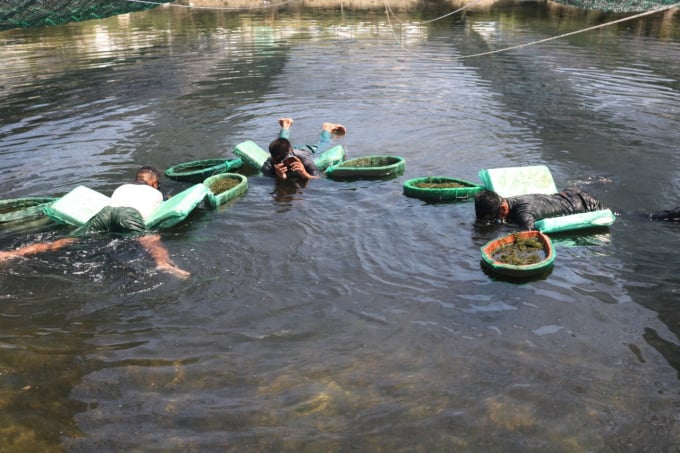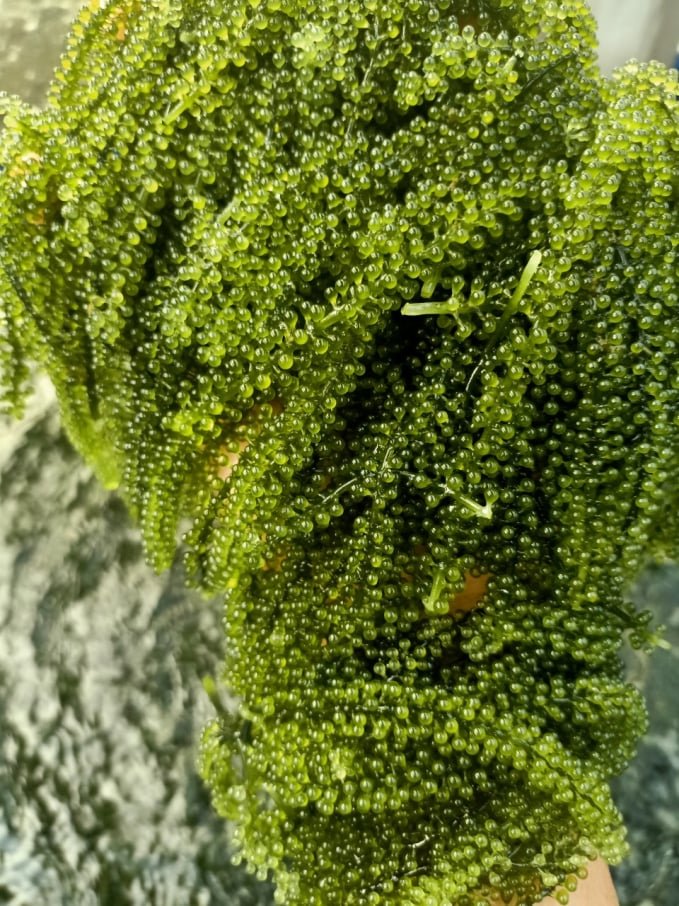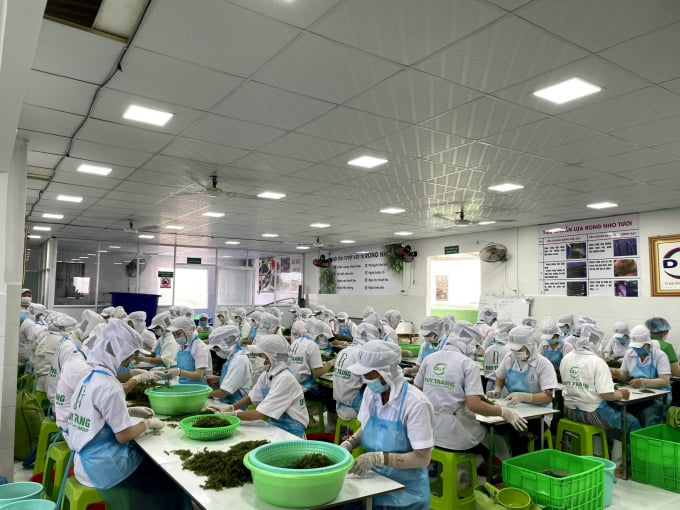November 19, 2025 | 06:28 GMT +7
November 19, 2025 | 06:28 GMT +7
Hotline: 0913.378.918
November 19, 2025 | 06:28 GMT +7
Hotline: 0913.378.918
From July 2021 to January 2022, the Directorate of Fisheries (DoF) and the World Wildlife Fund for Nature of Vietnam (WWF-Vietnam) proposed and developed a project themed "Building a Sustainable Seaweed Chain in Vietnam".
To complete the project, the DoF in collaboration with WWF-Vietnam held a workshop on February 16, in Nha Trang City, Khanh Hoa Province to share opinions and consult on its implementation.
At the workshop, Mr. Nguyen Van Giap, an expert, and representative of the consulting group reported on results of analyzing the seaweed value chains including those for grape seaweed (Caulerpa centiliter) and cartilage seaweed (Kappaphycus Alvarezii). Accordingly, Vietnam currently has a diverse marine ecosystem such as lagoons, rocky beaches, and coral reefs, suitable for seaweed farming.

Harvesting grape seaweeds in Ninh Hai Ward, Ninh Hoa Town, Khanh Hoa Province. Photo: KS.
Currently, the potential area for growing cartilage seaweed in the whole country is about 900,000ha (equivalent to 600,000 – 700,000 tons of dried seaweed/year). Among over 800 seaweed species, 90 have economic values.
Vietnam has 20 species of seaweed containing agar, of which 7 are common species with high economic value such as grape seaweed, cartilage seaweed, and others with scientific names as Gracilaria Tenuistipitat, Gracilaria Firma, Gracilariopsis Bailinae, Kappaphycus Striatus, and Ucheuma Denticulatum.
Grape seaweeds were imported to Khanh Hoa in 2004 and have been successfully grown in this province. The potential growing area is about 400ha, mainly in Khanh Hoa. Currently, grape seaweeds are grown in about 100ha with a yield of 10-20 tons/ha/year. The selling price stands at about USD8-10/kg of fresh products.

Grape seaweed is very nutritious and good for health. It has been trusted by Japanese people for over 25 years. Photo: KS.
Cartilage seaweed is now grown in the provinces of Ninh Thuan, Khanh Hoa, Phu Yen and Binh Dinh. The potential area for growing this seaweed is about 10,000ha but only 900ha have so far been cultivated. Cartilage seaweed has a yield of 20-30 tons/ha/year and is sold at about USD0.1/kg of fresh products.
Regarding seaweed processing, currently, 40% of Vietnam seaweed fresh products are processed into white seaweed for food and sold across the country. Seaweed in Vietnam is used for producing value-added products such as snacks, supplementary foods, food additives, and confectionery. More and more businesses are participating in the field of seaweed processing and marketing.
By 2020, the cultivation area will reach about 15,000ha, with an output of 135,000 tons. In which, profits from grape seaweed account for about VND150 million/ha and VND60 million/ha from cartilage seaweed.

Grape seaweed processing area of D&T Company in Khanh Hoa. Photo: KS.
Mr. Tran Dinh Luan, DoF General Director said: “A few years ago, Japanese experts were invited to Vietnam to speak about potentials and advantages of seaweed development and that was the beginning to develop the industry in Vietnam. Now is the time for us to develop the seaweed sector better, but it must attach to a chain of linkages so that members of the chain can earn a good living condition from economic efficiency and contribute to the whole sustainable development.”
"Therefore, over the past time, the consulting group has come to localities and talked with businesses to conduct surveys. We have also met with jelly processing enterprises to discuss this issue to promote the potential of the seaweed industry. On the side of seaweed processing enterprises, they are also very determined to develop, both to help coastal people improve their lives, and businesses to have more raw materials and limit their imports," said Luan.
At the workshop, participants commented on the project saying that to develop the grape seaweed chain, it was necessary to have quality facilities to provide seedlings for farmers. Along with that, the project should promote the application of high technology in production to improve seaweed yield and quality. It should also promote the use of a certification system to check the cultured seaweed’s quality, ensuring biosecurity and safety for the ecological environment. Along with preferential loans, there should be policies to support and encourage small-scale seaweed farming households to link up to the sustainable chain.
According to Mr. Luan, climate change and emission reduction were among the concerning issues. Recently, the Prime Minister who attended COP 26 in the UK, wanted to develop the economy but said it should ensure emissions reduction and promote potential advantages. Therefore, the exploitation of water surface potentials, especially those in the central provinces to develop seaweed, will help local people who are small-scale miners along the coast, change their jobs.

Processing grape seaweed at D&T Company. Photo: KS.
As seaweed can help promote fully the potential in seawater areas, growers will not waste investment in labor, care, and protection of their farms but can earn profits from their marine products especially from seaweed which now have become popular a trend in consuming markets.
“If production is organized well, the industry will become one of the ways to help coastal people live better and better. This is also a direction to strengthen the protection of aquatic resources. We can develop models of seaweed production as aquatic resource protection and co-management zones, or management through cooperatives and co-operative groups associated with processing and consumption," said Mr. Luan.
Mr. Luan said the implementation of this project will ensure two goals, namely, protecting, conserving coastal resources, and improving the living standards of local coastal people. In addition, we can develop products associated with rural tourism and craft village tourism... At the same time, developing seaweed farms can also help exploit potential advantages with the lowest cost and high economic efficiency and protect the environment, and biodiversity ecosystems.
According to Luan, currently, demands for seaweed processing are very large. Besides the Long Hai jellyfish processing enterprise, localities also participate in purchasing seaweed products through local Farmers' Associations but supply was still not enough so they have to import thousands of tons of dried seaweed from other countries. “For this project, we have cooperated with many partners such as the Netherlands, Europe and the US to help Vietnamese enterprises in processing higher value products. From then on, it will help exploit and expand the potential areas, extend the value chain and move towards circular agriculture", Mr. Luan shared.
Translated by Linh Nguyen

(VAN) Integrating agricultural extension activities with ecotourism development unlocks promising new avenues for localities boasting specific advantages in grape and apple cultivation.

(VAN) Enterprises and cooperatives accompany farmers in Tay Ninh to develop an organic seedless lime growing area, paving the way for poverty reduction.

(VAN) There were times when Pho faltered, yet his aspiration to bring the pure aroma to those who truly value clean tea kept urging him forward.

(VAN) Bich Thao Coffee Cooperative pioneered products achieving the national 5-star OCOP standard, paving the way for Son La coffee to conquer international markets.

(VAN) The Bao La bamboo-and-rattan cooperative has been producing goods integrated into value chains. As a result, its products have reached global markets.

(VAN) The training course in An Giang equips learners with emission verification methods, thus creating a basis for low-emission rice production.

(VAN) Thu Lum commune is focusing on developing medicinal plants under the forest canopy, creating sustainable livelihoods for local people, and contributing to protecting the ecological environment.